Click on images to enlarge
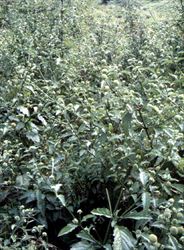
infestation (Photo: Land Protection, QDNRW)

habit prior to flowering (Photo: Land Protection, QDNRW)
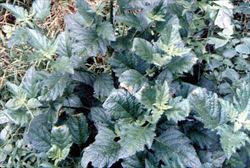
lower leaves (Photo: Land Protection, QDNRW)
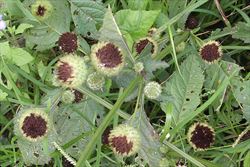
upper leaves and flower clusters (Photo: Chris Gardiner)
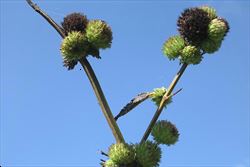
four-angled stems with clusters of immature and mature fruit (Photo: Chris Gardiner)
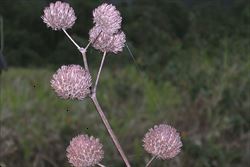
clusters of old fruit (Photo: Chris Gardiner)
Scientific Name
Hyptis capitata Jacq.
Family
Labiatae (South Australia)Lamiaceae (Queensland, New South Wales, the ACT, Victoria, Tasmania, Western Australia and the Northern Territory)
Common Names
buttonweed, false ironwort, knobweed, wild-hops
Origin
This species is native to southern Mexico, Central America (i.e. Belize, Costa Rica, El Salvador, Guatemala, Honduras, Nicaragua and Panama), the Caribbean and tropical South America (i.e. Venezuela, Colombia, Ecuador and Peru).
Naturalised Distribution
Knobweed (Hyptis capitata) is not yet widely naturalised in Australia, and is mostly confined to the coastal areas of northern Queensland. It has also been recorded in central Queensland, the Northern Territory and on Christmas Island.
It is also widely naturalised in tropical Asia (e.g. Vietnam, Thailand, Singapore, Malaysia, Indonesia and the Philippines) and on several Pacific islands (e.g. Hawaii, Western Samoa, Solomon Islands, Palau, Guam and French Polynesia).
Habitat
This species is mainly found in wetter tropical and sub-tropical environments. It is a weed of disturbed sites, crops, pastures, roadsides, waterways and open woodlands.
Habit
A large upright (i.e. erect) herbaceous plant with several branching stems (50-250 cm tall) arising from a long-lived (i.e. perennial) rootstock.
Distinguishing Features
- a large upright herbaceous plant with several branching stems growing 60-250 cm tall.
- its stems are four-angled and its widely spaced leaves are oppositely arranged.
- its leaves have irregularly toothed margins and small oil glands on their undersides.
- its small white flowers are borne in stalked globular clusters (about 15 mm across) and are surrounded by green tubular structures.
- these flower clusters turn brown when mature and contain small 'seeds' which rattle when the stems are shaken.
Stems and Leaves
The hairy (i.e. pubescent) stems are four-angled (i.e. quadrangular) and usually develop pairs of branches in the upper leaf forks (i.e. axils).
The bright green leaves (5-15 cm long and 2-6 cm wide) are oppositely arranged and widely spaced along the stems. They are borne on stalks (i.e. petioles) 2-3 cm long and are egg-shaped in outline (i.e. ovate) or oblong in shape. The leaf blades have irregularly toothed (i.e. serrate) margins and pointed tips (i.e acute apices). Small oil glands are usually present on the undersides of the leaves.
Flowers and Fruit
The small white flowers are arranged in dense rounded clusters (15-25 mm across) that resemble flower-heads. These flower clusters are borne on stalks (i.e. peduncles) 2-9 cm long and are produced in the upper leaf forks (i.e. axils). The individual flowers are stalkless (i.e. sessile) and the white petals of these flowers (5-6 mm long) are partially fused into a tube (i.e. corolla tube). They separate into two lobes near the top (i.e. they are two-lipped). The lower of these lobes is inflated (i.e. saccate) and bent sharply downwards (i.e. deflexed), while the upper lobe usually has some faint purplish spots. Each of these small flowers is surrounded by a green tubular structure (i.e. calyx tube) with five lobes, which is made up of the fused sepals (3-4 mm long). Flowering usually occurs during late autumn and early winter.
The fused sepal tubes (i.e. the calyces) become enlarged (up to 10 mm long) after the flowers die, and they eventually turn brown in colour. Inside each of these calyx tubes a small four-lobed fruit (i.e schizocarp) is produced, which divides into four small 'seeds' (i.e. nutlets or mericarps). These 'seeds' are dark brown to black in colour (1-2 mm across) with two distinct white markings at one end. They are relatively smooth in texture and almost rounded (i.e. sub-globular) in shape.
Reproduction and Dispersal
This species reproduces mainly by seed. The seeds are often spread in the fruit which readily adhere to animals, clothing and vehicles. They may also be dispersed by water, machinery, or in contaminated agricultural produce. The long-lived rootstocks can occasionally also be spread by cultivation practices.
Environmental Impact
Knobweed (Hyptis capitata) is regarded as an environmental weed in northern Queensland and as a potential environmental weed in the Northern Territory. This species prefers to grow in disturbed sunny areas on heavy soils with above average moisture levels. It can form dense thickets and is a common weed of roadsides, creekbanks, headlands and overgrazed pastures in northern Queensland. Its main effect is to dominate or replace the natural shrub/herb layer of more open plant communities, though it is regarded to be invading relatively slowly.
Knobweed (Hyptis capitata) mainly occurs in tropical wet lowlands and foothills of the Ingham-Cairns region. It has also been recorded along road and powerline corridors in the Wet Tropics World Heritage area. It was also discovered in Kakadu National Park in the Northern Territory in 1997, and this population is subject to an eradication program.
Other Impacts
This species is also a weed of crops and pastures in northern Australia.
Legislation
This species is declared under legislation in the following states and territories:
- Northern Territory: B - growth and spread of this species to be controlled (throughout all of the Territory) and, C - not to be introduced into the Territory.
- Western Australia: Prohibited - on the prohibited species list and not permitted entry into the state.
Management
For information on the management of this species see the following resources:
- the Northern Territory Department of Natural Resources, Environment and The Arts Agnote on this species, which is available online at http://www.nt.gov.au/weeds.
Similar Species
Knobweed (Hyptis capitata) is relatively similar to hyptis (Hyptis suaveolens) and lion's tail (Leonotis nepetifolia). These species can be distinguished by the following differences:
- knobweed (Hyptis capitata) has white flowers that are borne in small dense globular clusters (15-25 mm across) at the top of stalks (i.e peduncles) 2-9 cm long.
- hyptis (Hyptis suaveolens) has pinkish, bluish-purple or lavender coloured flowers that are borne in loose few-flowered clusters in the leaf forks (i.e. axils).
- lion's tail (Leonotis nepetifolia) has orange flowers that are borne in large stalkless (i.e. sessile) globular clusters (50-60 mm across) in the upper leaf forks (i.e. axils).

